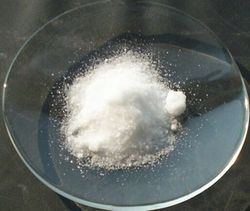Molar mass 208.47 g/mol Density 4.69 g/cm³ | Melting point 1,000 °C | |
 | ||
Appearance White hygroscopic solid | ||
Cadmium sulfate is the name of a series of related inorganic compounds with the formula CdSO4·xH2O. The most common form is the monohydrate CdSO4·H2O, but two other forms are known CdSO4·8/3H2O and the anhydrous salt (CdSO4). All salts are colourless and highly soluble in water.
Contents
Structure, preparation, and occurrence
X-ray crystallography shows that CdSO4·H2O is a typical coordination polymer. Each Cd2+ center has octahedral coordination geometry, being surrounded by four oxygen centers provided by four sulfate ligands and two oxygen centers from the bridging water ligands.
Cadmium sulfate octohydrate can be prepared by the reaction of cadmium metal or its oxide or hydroxide with dilute sulfuric acid:
CdO + H2SO4 → CdSO4 + H2OCd + H2SO4 → CdSO4 + H2The anhydrous material is prepared using sodium persulfate:
Cd + Na2S2O8 → CdSO4 + Na2SO4Cadmium sulfate occurs as the very rare mineral drobecite (CdSO4·4H2O).
Applications
Cadmium sulfate is used widely for the electroplating of cadmium in electronic circuits. It is also a precursor to cadmium-based pigment such as cadmium sulfide. It is also used for electrolyte in a Weston standard cell as well as a pigment in fluorescent screens.
